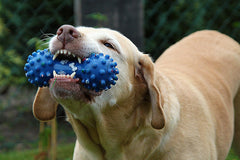
Did you know that 66% of US households owned a pet? And that only 14% owned both dogs and cats?
People like to say, "I'm a dog person," or "I'm a cat person." Yet, for some reason, people rarely say that they like both. Even more interesting is that it is more common for households to own two dogs or two cats rather than one dog and one cat.
Based on friends I spoke to, there seems to be often a reason for having both. For example, my girlfriend's parents have owned a dog for a few years now. She is a Chihuahua called Pepa. A few months back, they rescued a kitten and decided to introduce her to their dog household. They named her Luna, and she is the most adorable white kittie.
Whether you decide to get a cat, or maybe you had to rescue one, I will go over the simple steps to introduce them to your dog.
Days 1-7: set up a safe room for your cat
Cats are creatures of habits, and before even thinking of introducing them to your dog, they need to feel safe. Choose a medium-sized room such as a spare bedroom or a laundry room, and set it up for your new cat: have some blankets, pillows, eventually a cat tree, their litter box, and a toy.
Place their food and water next to the door. Place your dog's food and water on the other side of the door (outside of the "safe room"). The idea here is to have them eat on opposite sides of the door. They will sense each other's presence but with the protection of the door and without face-to-face confrontation.
Days 2-7: swap scents
Pets rely on scents to know whether it is safe or not. Therefore, before they even get a chance to see each other, you will want to introduce them to the other's scent.
You can swap a blanket your cat sleeps on with your dog's bed. You can also do this with toys.
Days 4-7: swap rooms
Towards the end of the first week, your cat should now feel at home and safe. Cats are curious creatures, and by then, they should want to explore the rest of your home. However, it is too soon for them to see your dog face-to-face.
To kill two birds with one stone, put your dog in the cat's safe room and keep the door closed while letting the cat roam free in the house. Your dog will finally see what is "on the other side of the door" and grow even more used to your cat's scent.
Meanwhile, your cat will become more confident and start to feel at home.
During these last few days of the first week, it would be ideal to have them see each other. So either you can open the safe room's door and install a baby gate so they can't touch each other, or keep your dog on a leash while he gets a glimpse of the cat.
Days 8+: introducing the cat to your dog
Now that the first week is over, your pets will be accustomed to each other's scent. They will have seen glimpses of each other and almost eaten side-by-side. Your cat will feel safe knowing his safe room and your house.
Make sure to have some treats ready for what follows. You will have short meeting sessions between your cat and your dog every day. Always keep your dog on a leash, and whenever they are behaving correctly, reward them with a treat.
For instance, while your cat roams free in the room, reward your dog if he stays calm with a treat. The idea is to create a positive association. If your dog gets overly excited or even starts being aggressive, redirect his attention to you and then reward him for his attention with a treat.
Slowly, they will start tolerating each other's presence more and more. You may begin with 15-minute sessions and steadily increase them to an hour or two.
After two to three weeks: no more barriers
Once you feel it's time or roughly after two to three weeks, you can start having these sessions without having your dog on a leash. Have a high place for your cat to escape, such as a cat tree or some shelves.
Remember that at this point, it is still best not to leave both roaming free together if you are not present.
After three to four weeks: no more supervision
They will no longer need your supervision after three to four weeks if all goes well. It may seem like a long time, but it is best to prevent aggression or injury. Both cats and dogs are territorial, and you are essentially asking them to share what they thought was their own.
To make the cohabitation work well, here are some more tips:
- Keep your cat's food out of reach—dogs like cat food.
- Keep your cat's litter box out of reach if your dog grows interested in it. You may use a baby gate or a tall, topless cardboard box so only your cat can access it.
- If you are reading this article because you just got a kitten, it is better to keep it separate from your dog until it is fully grown.
If you enjoyed reading this article and don't want to miss out on more fun stuff about pets, sign up below.




